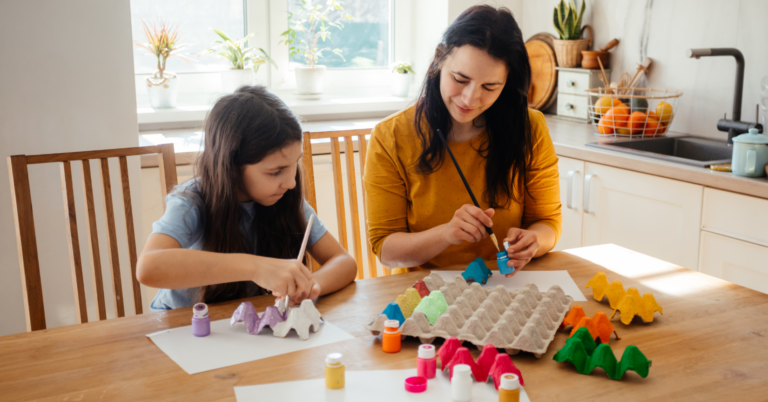Being a parent who truly understands your child’s learning style can unlock a world of potential for them. It’s about tapping into their unique way of absorbing information and tailoring your teaching techniques to fit.
Yes, it can be a game-changer. It’s like finding the key to their minds, opening doors to knowledge and understanding in ways they naturally resonate with.
In this article, we’re going to explore 6 effective teaching methods specifically designed for parents who have grasped their child’s learning style. These techniques are not one-size-fits-all solutions but rather flexible strategies that can be modified to best suit your child’s unique learning needs.
1. Harness emotional intelligence
Understanding your child’s emotions is a powerful tool in effective teaching. Emotional intelligence, or EQ, is the ability to identify and manage one’s own emotions, as well as the emotions of others.
Children are inherently emotional learners. They absorb information not just through their minds, but also through their hearts. As parents, we need to recognize this and use it to our advantage.
Start by observing your child’s emotional responses to different learning situations. For example, do they become frustrated when they can’t solve a math problem? Do they feel excited when they succeed in a science experiment? These emotional responses can provide clues about their learning style.
Next, tailor your teaching methods to accommodate these emotions. If your child gets frustrated easily, you might need to break down complex problems into simpler steps. If they thrive off success, make sure to celebrate their achievements to motivate them further.
Understanding and responding to your child’s emotions can enhance their learning experience. It creates a safe and supportive environment where they feel seen, understood, and encouraged to learn.
Using EQ in teaching is not a one-off task but an ongoing process of observation, adaptation, and communication. But the rewards it yields – in terms of your child’s learning outcomes and your relationship with them – are immeasurable.
2. Personalize the learning process
Every child is unique, and so is their learning style. Personalizing the learning process means adapting your teaching methods to align with your child’s individual learning style.
There are generally four types of learning styles: visual, auditory, reading/writing, and kinesthetic. Visual learners prefer seeing and observing things, auditory learners learn best through listening, reading/writing learners prefer written information, and kinesthetic learners learn best through hands-on experiences.
If your child is a visual learner, use diagrams, charts, pictures, and videos in your teaching. For an auditory learner, incorporate more spoken instructions and discussions. If your child learns best through reading and writing, provide plenty of textual resources. And for kinesthetic learners, engage them in practical activities and experiments.
Personalizing the learning process enhances engagement and maximizes learning outcomes. It means teaching in a way that resonates with your child’s preferred method of learning, making the process more enjoyable and effective for them.
While it might require a little extra effort and creativity on your part to personalize the teaching methods, it is definitely worth it. The positive impact on your child’s learning journey is profound.
3. Incorporate real-life applications
One of the most effective teaching techniques is to incorporate real-life applications into your child’s learning process. This approach helps children understand why what they’re learning is important and how it applies to the world around them.
When your child is learning about fractions, take them to the kitchen and let them measure ingredients for a recipe. For geography lessons, consider planning a virtual trip to a place they’re studying about.
By connecting learning with real-life situations, you’re not just teaching your child about a specific topic, but also equipping them with skills they can use in their everyday life. This makes learning more relevant and engaging for them.
4. Utilize technology
In the digital age, technology is a powerful tool for effective teaching. It offers a wealth of resources that can make learning more engaging and interactive for your child.
Related Stories from Careful Parents
From educational websites and apps to online courses and videos, there’s a wide array of digital resources you can use to supplement your teaching. These resources cater to different learning styles, making it easier for you to personalize your child’s learning experience.
For example, visual learners might benefit from educational videos or graphics. Auditory learners can benefit from podcasts or audio lessons. Reading/writing learners can find plenty of e-books and articles online, while kinesthetic learners can engage in interactive online activities or games.
While technology is a fantastic tool, it’s also essential to ensure that it’s used wisely. Set boundaries on screen time and make sure the content your child is accessing is safe and age-appropriate. Technology should be a tool that enhances learning, not something that overwhelms or distracts your child from their studies.
5. Encourage self-paced learning
Recognizing your child’s learning style is the first step, but allowing them to learn at their own pace is equally significant. Self-paced learning respects the individual learning speed of each child and allows them to fully grasp a concept before moving on to the next.
This approach can reduce stress and increase enjoyment in the learning process. Your child doesn’t have to feel rushed or pressured to keep up with a certain pace, which can often lead to a lack of understanding or even a dislike for learning.
For self-paced learning to work effectively, it’s vital for parents to provide guidance but also allow their child the freedom to explore topics they’re interested in. This encourages curiosity and promotes a love for learning.
In self-paced learning, patience is key. Every child learns at their own speed and it’s more important that they truly understand and enjoy the learning process, rather than rushing through topics just to meet a certain timeline.
6. Foster a growth mindset
The final, but possibly the most crucial technique, is fostering a growth mindset in your child. A growth mindset, a term coined by psychologist Carol Dweck, is the belief that abilities and intelligence can be developed through dedication and hard work.
Instilling a growth mindset in your child can transform their attitude towards learning. It encourages them to embrace challenges, persist in the face of setbacks, and see effort as a path to mastery. It’s about teaching them that it’s okay to make mistakes and that these mistakes are valuable learning opportunities.
To foster a growth mindset, use constructive feedback and encourage resilience. Celebrate the process of learning, not just the outcome. Encourage curiosity and nurture their passion for learning.
Fostering a growth mindset is not just academic success. It’s teaching your child valuable life skills like perseverance, resilience, and adaptability – skills that will serve them well beyond the classroom.
Embracing a holistic approach to learning
We believe in the importance of a holistic approach to learning. This means going beyond academics and focusing on the overall well-being of your child.
A holistic approach to learning integrates mindfulness and emotional intelligence, teaching your child to recognize and manage their emotions, be present in the moment, and cope with stress. These skills enhance learning and contribute to overall mental and emotional well-being.
Furthermore, a holistic approach promotes a balanced lifestyle by emphasizing the importance of physical activity, healthy eating, and sufficient rest alongside academic pursuits.
Ultimately, it nurtures a genuine enthusiasm for learning in your child. When children are genuinely interested in learning, they become self-driven and take responsibility for their education. This fosters a lifelong love for learning, shaping them into curious, resilient, and adaptable individuals.
As parents, our goal is not just to teach our children but to guide them in becoming well-rounded individuals who are equipped with the necessary skills to navigate life. Embrace a holistic approach to teaching and witness the transformative power it has on your child’s learning journey.







